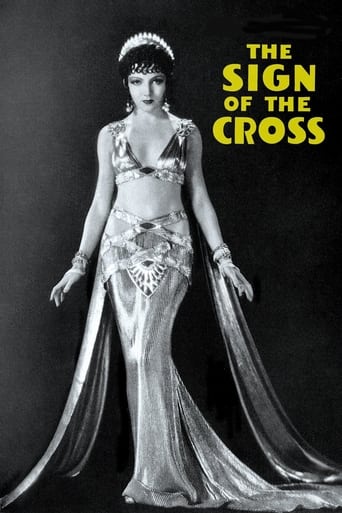jacobs-greenwood
A pre-code epic by director-producer Cecil B. DeMille featuring one of my favorite actresses, Claudette Colbert in the famous milk bath scene, as well as the great Fredric March. It's near the end of the Roman Empire, Nero fiddles while Rome burns, and Christians are fed to the lions. Karl Struss received an Oscar nomination for his Cinematography. Another version of the story can be seen in Quo Vadis (1951).In 64 A.D., Marcus Superbus (March) is the great warrior of Rome who falls for Mercia (Elissa Landi), a Christian girl. However, Marcus is coveted by Poppaea (Colbert), the wife of Nero (Charles Laughton), who can influence the Emperor. Another with this ability is Tigellinus (Ian Keith), a warrior jealous of Marcus's power. Tigellinus asserts his influence over Nero to have the blame for Rome's burning blamed on the Christians, so that they can be rounded up and/or executed.Titus (Arthur Hohl) brings news from Jesus's disciple Paul, making the acquaintance of fellow Christian Favius (Harry Beresford) by making the "sign of the cross" on the ground. Nat Pendleton, a loyal Roman "thug", witnesses this as well as Marcus's saving of Mercia, Titus, and her father Favius, and reports it to Tigellinus. Meanwhile, the Christians are planning a big meeting for Titus's report, and Favius's son Stephan (Tommy Conlon) will be used to pass the secret location & time to others. However, he is captured (by Pendleton) and tortured by the Romans to reveal the information such that Tigellinus takes his troops to ambush and kill the Christians.When Marcus hears of this, he and men loyal to him rush to the scene, but are delayed by Poppaea, who is jealous of anything which draws him away from her. So they arrive too late to stop Tigellinus's slaughter of many of the Christians including Titus and Favius. The rest are imprisoned to later be fed to the lions, bears, alligators, and even crushed by elephants as entertainment for spectators in the Colosseum.However, Marcus has his second in command, Lecinius (William Mong), take Mercia to his home where she can be protected. There, she witnesses debauchery as he tries to get her to renounce her religion to be safe and live with him. She resists and instead tries to "save" him. There's a great dance sequence featuring Ancaria (Joyzelle Joyner) as she and Marcus's house guests try to corrupt Mercia. There's another scene in which Poppaea (with Colbert dressed to kill;-) tries to sway Marcus's favor, only to be rejected such that she uses her influence with Nero to have Mercia taken from his residence.I won't reveal the ending, except to say that it's both tragic and hopeful. Also, Charles Middleton plays Tyros, and Mischa Auer and John Carradine appear uncredited in this large production.
David Atfield
How did DeMille do it? How did he make a film that is wildly decadent, revelling in the debaucheries of Ancient Rome, while still making it a moving tribute to the Christian martyrs of the time? The way he balances spectacle, comedy, drama, moralising and debauchery is pure genius! If you've never seen a pre-Hollywood-production-code movie before you may be surprised to see a glimpse of Claudette Colbert's nipples as she's bathing in milk, to see an erotic lesbian dance sequence, to see a naked young man sitting next to the very gay Nero of Charles Laughton! And then DeMille joyously recreates a whole day of gruesome spectacles in the arena in all their gruesome detail. But then, somehow, he switches the whole mood and, thanks to excellent performances from Fredric March, Elissa Landi and young Tommy Conlon, creates a deeply moving finale, that tragically anticipates the horrors of the Holocaust. An amazing film in every way, and so much better than "Quo Vadis"!
Tashtago
In typical DeMille fashion and perhaps on purpose he makes the object of his morality (the Romans) more fascinating than the people (Christians) we are supposed to identify with. The film is slow and plodding as many of the early talkies were with the transition from silent to sound taking until about 1934 before directors were comfortable enough in the new medium to create more cinematic stylish films. However, the bonus to many of the first sound films was a lack of censorship that movie goers would not witness again until the 1960's . Here we have pre-code semi-nudity, sexual suggestion of threesomes, orgies , and lesbianism, as well as the truly horrific games sequence at the end of the film. All in all there is a lot to take in with the Sign of the Cross, and much of the acting Laughton, Colbert, March is very good unfortunately the film suffers from snails pacing and too much killjoy preachiness.
omb19713
Many of the comments refer to the Colosseum. This is an error made by movie makers themselves. There were other sites for games in the early Roman Empire. The building of the Colosseum was finished in 80 AD. Nero died in 68 AD. It is actually the Flavian Amphitheatre. It was built partially on the site of Nero's House of Gold. This infamous palace complex had a large lake. The Colosseum was build over the remains of the lake bed. The name Colosseum refers to a large statue of Nero which was in this complex. The persecutions under his reign most likely took place in the Circus of Caligula/Nero on the site of the present day Vatican.




